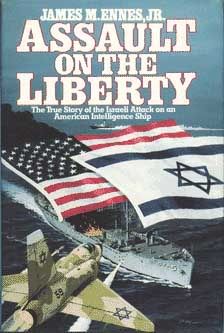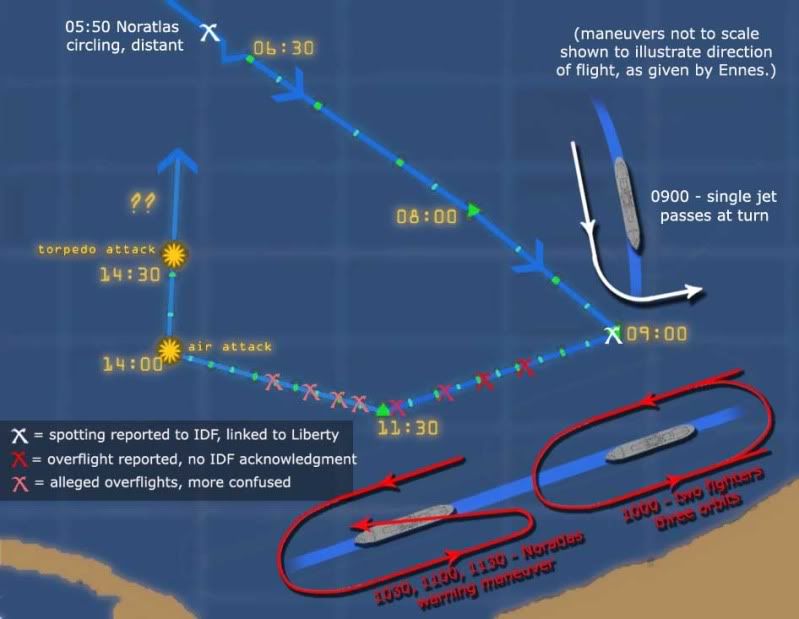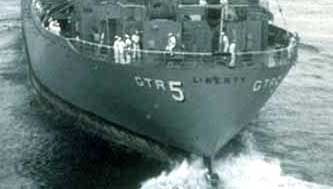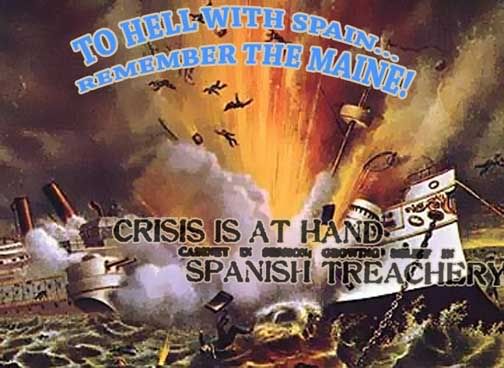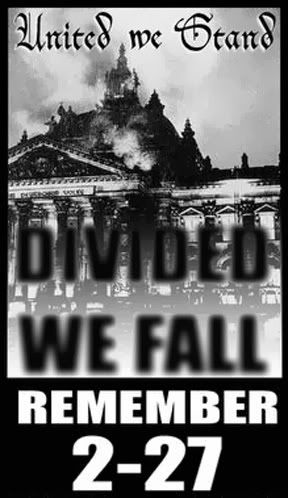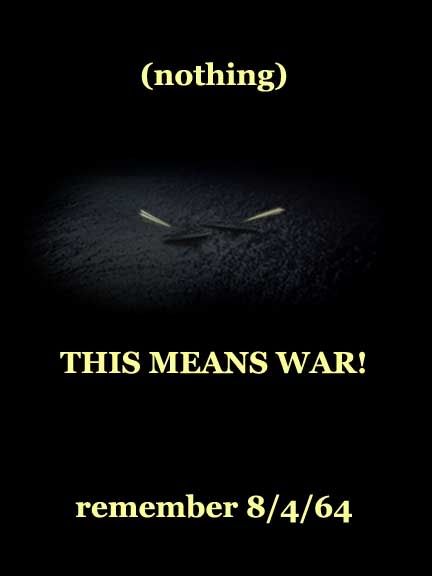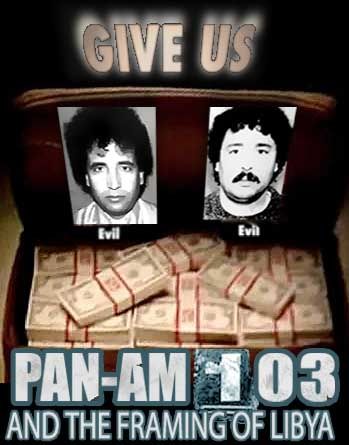Adam Larson / Caustic Logic
[USS Liberty series]
July 8 2009, last update 7/31
RESPONSIVE RECORDS
Apparently spurred by the Bamford/Nowicki revalations about recorded intercepts of the Liberty attack (as covered in part two), Judge A. Jay Cristol moved to have any such tapes declassified, He was probably confident they would show what he knew the IDF communications to show (as covered in part three) – the attackers had no idea they were attacking an American vessel, and all IDF parties missed the U.S. flag until well after they had stopped “screwing her.” Cristol filed a FOIA request with the National Security Agency (NSA) in April 2001 for release of any transmissions, on the day of the attack, to or from USS Liberty, USS Amberjack (submarine, long story), or the EC-121 everyone was talking about at the time. [1]
The judge gave them nearly two years before deciding the agency had “failed to comply” and he launched a lawsuit, via the U.S. District Court for Southern Florida, in January 2003. [2] This was sufficient to jar things loose; after a brief back-and-forth over details of the request, successful declassification was announced by the NSA’s Director of Policy on July 2 2003. Searches for the first two, anything from the ephemeral Amberjack or from spy ship Liberty (verified to be near the attack) revealed “no records responsive.” However the then-secret agency did manage to gather some intel from the plane, on tapes they still had around. These were declassified, and sent to Cristol in original audio and translated transcripts. [3] These amazing primary source materials arrived only after his book had been printed, but he was missing less than you might think - the 2003 release is far more noteworthy for what it doesn’t clarify than what it does.
THE CONTENTS: REALITY OR RITUAL?
The tapes are of voice communications, in Hebrew, and cover the time frame 1429 to 1519 local time. The start point of 2:29pm is about 15 minutes after the air attackers left, and six minutes before the MTBs fired their torpedoes. Thus it starts within “the attack” time span, and ends at 15:19, a few minutes after the flag was reported by the helicopters. The 50 minutes of audio between is only of talk between the “Super Frelon” helicopters and their IAF controllers at Hazor Airfield. These two birds were never involved in the attack and only arrived well after it was done to assess the situation and offer any help needed (opinions on the type of "help" intended differ). Most of the intercept is long, dull stretches of “are we there yet?” “Where are you?” “We’re over here” type chatter. Both audio (.wav) and transcripts (.pdf) are available for download here.
The tapes do show, on this limited level, an apparent confusion about the nationality of the crew, perhaps reflecting the back-and-forth between the "hunches" of some and the heedlessness of others. En route Hazor tells them the target is an Egyptian warship, and then and Egyptian supply ship. Then some doubt becomes evident just before they got on the scene; since there was supposedly “no flag on her!” it was to imperative to figure out where they came from. It was decided that only pulling survivors from the water or landing on the ship and interrogating them would do, and both options were discussed. English or Arabic were the specified languages to listen for. Someone was always wondering about "Americans," even though they supposedly had no reason to (see hunch link and part three) until after the flag was seen. But here it starts just before.
Upon arrival, the first helicopter reports the hull number again as “CTR-5” (which still meant "noting") and no visible flag, while the second apparently reported the American flag. This must occur somewhere a little before 15:12 (around 22:50 in the audio of tape 105). Although he’s present earlier describing the scene, and does seem to confirm with the controller after this, the pilot is not to be heard actually reporting a flag, on the audio or paper versions. Preceding the flag talk is at least two minutes of the controller talking one-way with no audible input from the helicopters. At 13:10:06 he warns the pilots to “watch out for the mast there,” which is where the flag should be seen. No response. Twenty seconds later he tells the lead pilot “take 810 with you, you’re both returning home.” Again no pilot response is heard. Thirty-six seconds later Hazor says, per the transcript:
13:12:03 Hazor: RGR, QSL, I understand.
13:12:08 Hazor: RGR, understand. Did you clearly identify an American flag?
13:12:13 Hazor: Thanks (Toda), stay over the area for now.
After an eight-second pause, the pilots finally pipe in, with the distinctive “choppy” chopper signal.
13:12:21 Pilot: [unknown statement, 3 sec, transcribed as “(CL)”]
13:12:31 Pilot: [unknown question, 1.5 sec, as “(CL)”]
13:12:36 Hazor: [answer, question, as “(CL)”]
13:12:40 Pilot: [short answer, not transcribed]
13:12:41 Hazor: They request that you make another pass and check once again whether it is really an American flag.
13:12:45 Pilot: RGR.
As on paper, the question in voce “did you clearly identify an American flag?” (22:59 in the wav audio) seems to come from nowhere. He was already aware that English might be spoken on the ship, and had seemingly heard nothing about such a sign, or anything at all, from the birds on the scene. Was he asking them to go ahead and verify the question scrawled on a napkin and slipped to him, after switching their channel back on? Sometimes these tapes sound more like ritual than reality.
RESPONSIVE REFLECTIONS
This release by NSA at the least failed to specifically contradict the IDF’s story that only the helicopter pilots spotted the flag. It supports it indirectly, in that the Hazor controller was certainly privy to no conclusive American ID, although he had the notion. However, the public had yet to see the rest of the recordings, the parts with the actual attack, during which the flag was also mentioned (according to the preponderance of American witnesses). Left hanging, different people drew different conclusions.
One side claimed, as they always have, that the issue was now closed. Judge Cristol told CNN in July "I don't think there's any question that anyone who reads these tapes would be absolutely convinced there was the fog of war out there […] I think this is probably the most important link in the evidence that ought to bring closure to this matter," Cristol said. [5] Somewhat more mildly, Israeli Embassy spokesman Mark Regev told CNN the tapes served as "further evidence that the Liberty incident was a terrible and tragic case of mistaken identity." [6] A July 9 Ha'aretz article, widely re-printed, was poorly titled "U.S. agency confirms sinking of USS Liberty was accident." [7]
Proof that it wasn’t fully sunk, Liberty survivor and early revisionist James Ennes, wrote in September that the ship’s crew “were pleased when we learned in June that apologists for our attackers had asked the federal courts to order the release of key intercept transcripts compiled during the attack.” He was confident that such tapes “would prove our case and disprove that of the apologists,” but “instead of releasing transcripts of the attack itself,” the NSA only put out tapes of the helicopters that “came afterward to clean up,” as he ambiguously describes their mission. [8]
Ennes finds that “nothing in the documents released suggests that [the attack] was an accident.” [9] To be fair, the tapes do show apparent confusion vis-a-vis the ship’s nationality, and other IDF records generally line up on the same confusion, with Soviet thrown into the mix at least at one point. [10] To me it’s exactly this confusion that makes no sense, given the broad sweep of ignorance required, making it less “fog of war” than “super-dense thunderhead of war.” Far more blinding, that, but it requires special conditions to form.
Even accepting the confusion in these tapes as genuine, characterizing it as proving the accidental attack theory is both misleading and common. “To our astonishment,” Ennes wrote, perhaps sarcastically, “the pro-Israel PR team put their own false spin on what was released. […] This false account was […] repeated as established fact - often with quotes from Chief Apologist A. Jay Cristol, proclaiming victory.” [11] A Baltimore Sun article from July 16 published some Cristol’s triumphant proclamations:
“[Cristol] says the recordings support his conclusion that the Israeli attackers had no idea they were targeting a U.S. vessel. […] "these tapes contain nothing showing that the attack was deliberate […] to me at least, they show it was a mistake […] nothing more of significance [remains] to be found. I think it will settle the matter for all but that 2 percent of die-hard conspiracy theorists.”” [12]
I suspect his math is wrong here on the numbers who would refuse to be distracted, it’s true that the “die-hards” (they survived rockets, napalm, torpedoes) were among them. So was Steve Forslund, who responded to these “only and final "tapes" that the NSA has released” in his statement to the Liberty Survivors' Assn. “Parties state that these are the only tapes of intercepts that exist. That may very well be true, now.” [13] But he apparently remains as steadfast as ever that the actual attack traffic was intercepted, transcribed in English and printed at his station at Offutt AFB, and showed an assault proceeding despite flag reports and pilot protests (see part one). The Agency disagrees.
UNDER THE BUS
The chief NSA linguist aboard the EC-121 in question, Marvin Nowicki, had to be disappointed. Like Forslund and others, he felt the transmissions he captured were of the attack and featured the stars and stripes. In his version, of course, this stops the attack. Judging by his past advocacy for release of the exculpatory recordings he remembered, Nowicki likely did something about this snub, quietly and respectfully. But there would be no more; in early June of 2007 the NSA “finalized the review of all material relative to the 08 June 1967 attack on the USS Liberty. This additional release adds to the collection of documents and audio recordings and transcripts previously posted to the site on 02 July 2003.” What was added was fairly minor, and included no additional intercepts. Again, they clearly affirmed that all they got was "voice conversations between two Israeli helicopter pilots [...] following the attack on the Liberty." "No communications were available [...] that might reflect the attack or reaction," they regretted to inform the pubic. [14] that June 8, the exact 40th anniversary of the attack, was selected for this statement served to amplify the deliberate finality of it.
The telex witnesses of part one, and Nowicki and his teammate all maintained the tapes “reflected the attack” quite clearly, as well as the U.S. flag. The NSA acknowledges only recordings that mention the ensign but well after the attack. This is noteworthy in that it offers a plausible explanation – all these men simply heard this helicopter talk and read in that the helicopters were involved in a vicious attack. For comparison, the man who captured these signals for the NSA has said:
“For the record, we (my teammate and I) both heard and recorded the references to the U.S. flag made by the pilots and captains of the motor torpedo boats.” [15] “[O]nly later in the afternoon did we hear references to [the] flag during the attacks.” [16] ”As I recall, we recorded most, if not all, of the attack.” [17]
There is little in these distinctive helicopter communications about seeing a ship and flying survivors to shore that could be construed as a two-phase air-sea attack being either carried out or called off. Nonetheless, many rational people will now conclude, however odd such a widespread embellishment seems, that they simply must have been confused.
So, Nowicki’s last chance had come and gone; the NSA decided everything it recorded can be released publicly, and his tapes weren’t on this last bus either. To mix metaphors, he was in fact left beneath this last bus as it rolled away into the night over his previous credibility. His tapes were never to return, obliviated down the memory hole. There’s been no comment since then, but his teammate – named as Michael Prostinak - was interviewed after this final thud, and told Chicago Tribune’s John Crewdson "I can tell you there were more tapes than just the three on the Internet," he said, referring to the NSA’s 2003 releases. "No doubt in my mind, more than three tapes." After inspecting these, “Prostinak said it was clear from the sequence in which they were numbered that at least two tapes that had once existed were not there.” These other tapes, unlike those released, contained clear language indicating an attack; Prostinak told Crewdson the people he heard “were not just tranquil or taking care of business as normal. We knew that something was being attacked." [18]
The agency disagrees.
---
Sources:
[1, 2] US District Court, Southern District of Florida. A. Jat Cristol v. National Security Agency. Case No. 03-20123. Stamped 21 Januart 2003. Accessed via: http://www.fas.org/sgp/foia/cristol.html
[3] http://www.fas.org/irp/nsa/liberty.html
[4] Hanley, Delinda. Those Not Invited to Speak Steal the Show at State Department Liberty Discussion. Washington Report on Middle East Affairs. March 2004. http://www.wrmea.com/archives/March_2004/0403009b.html
[5, 6] Ensor, David. “USS Liberty attack tapes released.” CNN.com. July 10, 2003. http://edition.cnn.com/2003/WORLD/meast/07/09/uss.liberty.tapes/
[7] Guttman, Nathan. “U.S. agency confirms sinking of USS Liberty was accident.” Haaretz. July 9 2003. Last Update: 09/07/2003. Found via: http://www.israelforum.com/board/showthread.php?t=3237
[8, 9, 11] Ennes, James M. “National Security Agency Documents on Attack on USS Liberty Prove What?” Washington Report on Middle East Affairs, September 2003, page 25. By James M. Ennes http://www.wrmea.com/archives/sept03/0309025.html
[10] See Division 914 War Log, 1451 entry. http://www.thelibertyincident.com/israellogs.html
[12] Shane, Scott. NSA tapes offer clues in '67 attack on U.S. spy ship. Baltimore Sun. July 16 2003. Found via: http://www.freerepublic.com/focus/f-news/947319/posts
[13] Forslund, Steve. Statement to USS Liberty Survivor’s Association. Undated (apparently 2003 or 2004). http://www.ussliberty.org/forslund.htm
[14] National Security Agency. Declassification initiatives: USS Liberty: What’s New? Posted January 15 2009. http://www.nsa.gov/public_info/declass/uss_liberty/
[15] Nowicki, letter to the Editor, Wall Street Journal. Published May 16 2001.
http://www.libertyincident.com/nowicki-wsj.html
[16] Nowicki. Exculpatory evidence supporting a mistaken attack
http://www.libertyincident.com/nowicki-evidence.html
[17] Nowicki. E-mail to James Bamforth [sic] March 3 2000. http://www.libertyincident.com/nowicki-email.html
[18] Crewdson, John. "New revelations in attack on American spy ship." Chicago Tribune. October 2 2007. Page 6. http://www.chicagotribune.com/services/newspaper/printedition/tuesday/chi-liberty_tuesoct02,0,1050179.story

